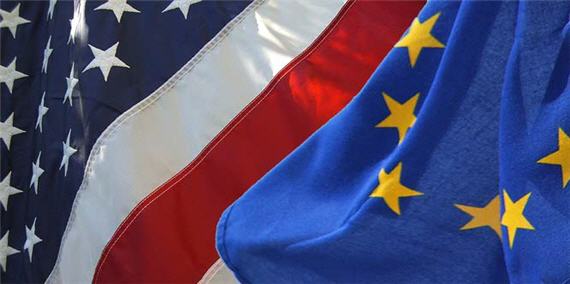
The Great Recession has appropriately focused America’s attention on its expected long-term economic decline relative to rising economies such as China, India, and Brazil. However, commentators have misconstrued this trend as necessarily implying a decrease in aggregate U.S. power without exploring potential strategic readjustments. Confronting this conventional wisdom, the U.S. should explore ways to increase its influence notwithstanding a lower economic base. In doing so, it can strengthen its persuasive capabilities through institutional links with the EU akin to a civilian NATO.
Indeed, President Obama expressed the same theme in his speech to the British Parliament a few weeks ago. Dismissing the “fashionable” doomsday predictions of “the decline of American and European influence around the world,” he argued that the U.S. and its European allies “remain the greatest catalyst for global action.” What is needed, however, is an effective institutional base to ensure such cooperation over the long-term, as we may not always have such farsighted leadership.
With power dividable into its military, economic, and persuasive components, U.S. strength in the first two areas is destined to decline. Over the next 20 years, the economic base of U.S. power is expected to decrease from 29% to 23% of world GDP, while China’s share will more than triple to over 16%. According to one assessment, China’s share of global power (based on a weighted average of output, population, and military spending) is expected to eclipse America’s by 2030.
However, these estimates consist of only hard power, which is easier to measure, and omit the persuasive component, which is less tangible though no less real. Yet, overall American power has fluctuated with its ability to persuade other effective actors and lead the world in serving common interests. Over the past 40 years, U.S. economic influence has remained largely constant in the range of 26-29% of global output, but its ability to accomplish its objectives has shifted depending on the conviction of other actors in America’s leadership. Even at its peak of material strength at the end of World War II when it accounted for nearly half of global GDP, the U.S. sought to identify areas of common interest with the rest of the international community and relied on persuasion, as much as coercion and inducement, to create the modern world order.
The test for current policy-makers is to show similar intellectual capability in generating common understanding for coordinated action.
For the time being, the most likely partner in this endeavor is the EU. Most EU countries are in a military alliance with the U.S. through NATO, are ultimately dependent (and will be even more so in the future) on U.S. guarantees of their security, and are more susceptible to U.S. influence than vice-versa. Given the EU’s internal restructuring with the emergence of its External Action Service, now is a particularly apt time to coordinate U.S. and EU foreign policy given the multitude of common challenges in the world—not least in Libya and throughout the Middle East.
Long-term U.S.-EU cooperation can be facilitated through innovative institutional arrangements. For instance, the State Department could sign memoranda of understanding with its national counterparts in the EU (and at the EU level) on potential areas of synergistic pooling of intelligence and analytical resources. For instance, policy planning staff could be seconded for twelve-month periods to enhance mutual assessment of long-term trends. Similarly, press offices could explore more frequent use of joint communiqués to express common positions on short-term problems.
These mechanisms would preserve U.S. sovereignty with ultimate freedom of decision, but would enhance its understanding of global issues by leveraging relative expertise of its allies and expand its potential resource pool by persuading allied countries regarding common objectives. (The same, of course, would apply conversely to each EU Member State.) Moreover, this process would help identify unnecessary overlap and areas to streamline resources while attaining the same purposes—a welcome benefit especially in a time of fiscal tightening.
In fact, initial steps in this general direction have already been taken. Last September, the National Intelligence Council and the EU Institute for Security Studies published the first-ever joint U.S.-EU assessment of foreign policy prospects and problems. The report “Global Governance 2025: At a Critical Juncture” was a collaborative effort between the two allies and could serve as a harbinger of greater coordination in the future that is forward-looking and pro-active rather than merely in response to a particular crisis.
Thus, stronger institutional links with the EU would increase U.S. aggregate power notwithstanding an inevitably declining economic base as a share of global GDP.
Bart Szewczyk is a member of the Executive Council at the American Society of International Law, fellow at the Truman National Security Project, and was a visiting fellow at the EU Institute for Security Studies. All views expressed herein are personal and do not necessarily reflect the author’s institutional affiliations.
Image: europe-usa-eu-flags.jpg
